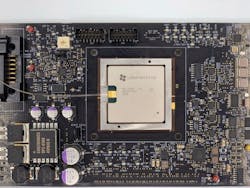Lightmatter touts optical processor chip for artificial intelligence applications
Boston-based startup Lightmatter says it is debuting a photonics-based processor chip designed to perform artificial intelligence (AI) inference acceleration at this week’s Hot Chips virtual event. Lightmatter Vice President of Engineering Carl Ramey is scheduled to present the photonic processor architecture today as part of the program.
The device uses light instead of electronics to compute and transport data within the chip. The photonic approach reduces heat dissipation and improves processor speed, says the company. Such performance and thermal improvements will be necessary as AI demands increase, Lightmatter points out.
“The Department of Energy estimates that by 2030, computing and communications technology will consume more than 8% of the world’s power. Transistors, the workhorse of traditional processors, aren’t improving; they’re simply too hot. Building larger and larger data centers is a dead-end path along the road of computational progress,” said Nicholas Harris, PhD, founder and CEO at Lightmatter. “We need a new computing paradigm. Lightmatter’s optical processors are dramatically faster and more energy efficient than traditional processors. We’re simultaneously enabling the growth of computing and reducing its impact on our planet.”
Lightmatter says the 3D-stacked chip package contains more than 1 billion FinFET transistors, tens of thousands of photonic arithmetic units, and hundreds of “record-setting” data converters. The photonic processor runs standard machine learning frameworks including PyTorch and TensorFlow to enable advanced AI algorithms, the company adds.
Lightmatter was founded by Harris, Darius Bunandar (chief scientist), and Thomas Graham (COO). The company is backed by GV (formerly Google Ventures), Matrix Partners, and Spark Capital. It raised $33 million in Series A funding, including a $22 million Series A-1 funding round announced in February 2019.
For related articles, visit the Optical Technologies Topic Center.
For more information on semiconductors and suppliers, visit the Lightwave Buyer’s Guide.
To stay abreast of optical technology advancements, subscribe to Lightwave’s Enabling Technologies Newsletter.
About the Author

Stephen Hardy
Editorial Director and Associate Publisher, Lightwave
Stephen Hardy is editorial director and associate publisher of Lightwave and Broadband Technology Report, part of the Lighting & Technology Group at Endeavor Business Media. Stephen is responsible for establishing and executing editorial strategy across the both brands’ websites, email newsletters, events, and other information products. He has covered the fiber-optics space for more than 20 years, and communications and technology for more than 35 years. During his tenure, Lightwave has received awards from Folio: and the American Society of Business Press Editors (ASBPE) for editorial excellence. Prior to joining Lightwave in 1997, Stephen worked for Telecommunications magazine and the Journal of Electronic Defense.
Stephen has moderated panels at numerous events, including the Optica Executive Forum, ECOC, and SCTE Cable-Tec Expo. He also is program director for the Lightwave Innovation Reviews and the Diamond Technology Reviews.
He has written numerous articles in all aspects of optical communications and fiber-optic networks, including fiber to the home (FTTH), PON, optical components, DWDM, fiber cables, packet optical transport, optical transceivers, lasers, fiber optic testing, and more.
You can connect with Stephen on LinkedIn as well as Twitter.
